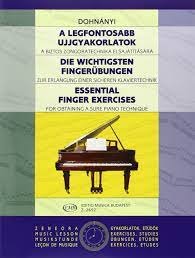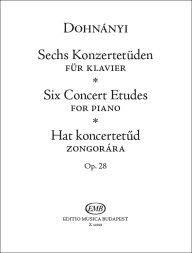Dohnányi – 6 Concert Études Op. 28 (with sheet music)
Ernö Dohnányi

Ernö Dohnányi wrote the following preface to his famous work Essential Finger Exercises for obtaining a sure Piano Technique or Die wichtigsten Fingerübungen zur Erlangung einer sicheren Technik:
In music-schools, piano tuition suffers mostly from far too much exercise material given for the purely technical development of the pupils, the many hours of daily practice spent on these not being in proportion to the results obtained.
Musicality is hereby badly neglected and consequently shows many weak points. The fault is, that the pupils are not taught to practice properly, and on the other hand, that far too many studies and exercises are given from which only little value can be gained, whilst not enough time is left for the study of repertory pieces.
Best Sheet Music download from our Library.
A few show-pieces are usually repeated to excess, as they are needed for public production, whereby the teacher’s reputation is generally more benefited than the pupil’s progress. Correct sense of style can, however, only be furthered by a sufficient knowledge of musical literature.
Therefore, before all else the amount of studies (« Études ») must be reduced and this can be cloned without harm if they are replaced by such exercises, which, in lesser time, bring forth the same benefits.
Finger exercises are preferable to studies (Études), if only for the reason that they can be practiced from memory, and consequently the whole attention can be concentrated on the proper execution, which is most important.
The preparatory degrees are not considered here.
Beginning with the middle stages, a judicious choice of studies by Cramer and Bertini suffices; later, a selection from Clementi’s Gradus) with the subservient finger exercises, is sufficient for obtaining a reliable technique.
Everything else, even Czerny, is superfluous; it does not contain anything of essential importance which might not be acquired through finger exercises, or by conscientious practicing of appropriate passages of pieces.
The Études by Chopin and Liszt belong of course to the category of concert-pieces, and play a part as important, for higher and highest stages, as Bach’s Two and Three Voiced Inventions in connection with Bertini and Cramer, and the Welltempered Clavier with Clementi.
Thus, by diminishing the amount of studies (Études), time is won for repertory music, and this time can be utilized still better, if only some of these concert pieces are practiced up to finishing stage; concerning the larger number of pieces, the teacher should be satisfied as long as they are played by the pupil in a clear and efficient manner. In the long run, the pupil will benefit by this.
A wide knowledge of musical literature can only be acquired by sight-reading. I cannot sufficiently recommend pupils to start early with sigh treading: piano-music as well as chamber-music.
I do not mean playing a piece once through, but to play it several times, so to become well acquainted with it. It may be argued, that this must lead into superficial, untidy («sloppy»), amateurish playing. The disadvantages of much sight-reading can be balanced by stricter demands put to the pupil, in regard to the performance of “concert-pieces”, and to the execution of studies and exercises.
Much sight-reading has however advantages, which are unfortunately not sufficiently considered. Independently of the great advantage of a wider knowledge of musical literature, thus acquired, the sense of style is improved, and it is also of use, in regard to technique, for the deftness and the surety of the :fingers are increased. The less time spent on purely technical studies, the more important it is to practice with full concentrated thought.
It is absolutely useless to practice exercises in a thoughtless, mechanical manner, especially when the eyes are riveted on the music. When playing, even the simplest of finger exercises, the full attention must be fixed on the finger-work, each note must be played consciously, in short: not to practice merely with the fingers, but through the finger with the brain.
As far as finger exercises are concerned, there are a number of works, which offer a vast field of profit and interest. They contain however too many exercises, the usefulness of which are questionable, when it comes to practical playing. After all, however technically well-equipped a pianist may be, certain difficulties have to be conquered by special practice during the study of the piece itself.
I do not speak of special cases, such as hands spoiled by bad training, deeply rooted faults etc., where special exercises are necessary.

In the following exercises, I have endeavored to collect material in condensed form, yet as complete as possible, which should help piano students to acquire a reliable technique. They are even all-sufficient for finished pianists to keep in training, and to retain the already acquired technique. Many exercises are new, do not however lay any claim either to originality or beauty. I hope, withal, that they will prove useful.
Budapest, June 1929.
Ernö Dohnányi
